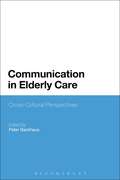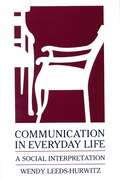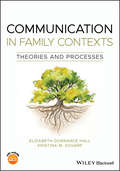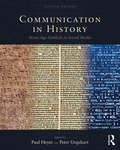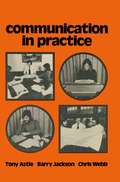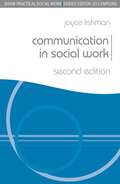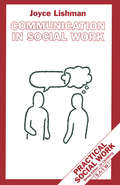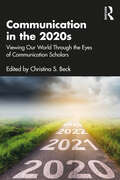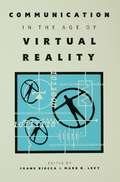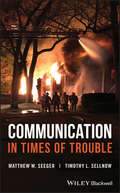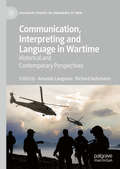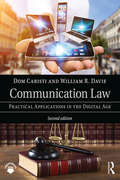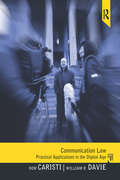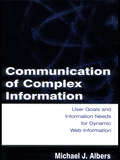- Table View
- List View
Communication in Elderly Care: Cross-Cultural Perspectives
by Peter BackhausThe topic of communication in elderly care is becoming ever more pressing, with an aging world population and burgeoning numbers of people needing care. This book looks at this critical but underanalyzed area. It examines the way people talk to each other in eldercare settings from an interdisciplinary and globally cross-cultural perspective. The small body of available research points to eldercare communication taking place with its own specific conditions and contexts. Often, there is the presence of various mental/physical ailments on the part of the care receivers, scarcity of time, resources and/or flexibility on the part of the care givers, and a mutual necessity of providing/receiving assistance with intimate personal activities.The book combines theory and practice, with linguistically informed analysis of real-life interaction in eldercare settings across the world. Each chapter closes with a "Practical Recommendations" section that contains suggestions on how communication in eldercare can be improved. This book is an important and timely publication that will appeal to researchers and carers alike.
Communication in Elderly Care: Cross-Cultural Perspectives (Continuum Studies In Linquistics Ser.)
by Peter BackhausThe topic of communication in elderly care is becoming ever more pressing, with an aging world population and burgeoning numbers of people needing care. This book looks at this critical but underanalyzed area. It examines the way people talk to each other in eldercare settings from an interdisciplinary and globally cross-cultural perspective. The small body of available research points to eldercare communication taking place with its own specific conditions and contexts. Often, there is the presence of various mental/physical ailments on the part of the care receivers, scarcity of time, resources and/or flexibility on the part of the care givers, and a mutual necessity of providing/receiving assistance with intimate personal activities.The book combines theory and practice, with linguistically informed analysis of real-life interaction in eldercare settings across the world. Each chapter closes with a "Practical Recommendations" section that contains suggestions on how communication in eldercare can be improved. This book is an important and timely publication that will appeal to researchers and carers alike.
Communication in Everyday Life: A Social Interpretation
by Wendy Leeds-Hurwitz(This book) is a clearly written and well-documented review of social communication theory, and an alternative to texts which focus primarily on the psychology of interpersonal communication and tend to exclude the social perspective on understanding interpersonal communication. Leeds-Hurwitz provides a welcome addition to introductory texts on the study of human communication. (This) is for teachers who have searched for an introductory textbook which presents a comprehensive argument for a social interactionist perspective on communication in a way understandable to students. Most refreshing is that Leeds-Hurwitz does not talk down to the reader, integrates (not just cites) original sources, and illustrates the concepts with ethnographic research…. Mark Kuhn, University of Maine, Orono in Communication Education
Communication in Family Contexts: Theories and Processes
by Elizabeth Dorrance Hall Kristina M. ScharpAn innovative, student-friendly textbook covering the major elements of the field of Family Communication Family Communication, a rapidly growing sub-discipline within Communication Studies, explores the processes and factors involved in family interactions and relationships. Communication in Family Contexts is a clear and accessible survey of the essential principles, theories, and concepts of the field. Unlike textbooks that present a vast amount of material across only a few chapters—this innovative textbook features brief, easily-understood chapters ideally-suited for undergraduate courses on the subject. The text provides concise yet comprehensive coverage of a diverse range of topics, from fundamental aspects of caretaking and sibling communication, to topics not covered in other textbooks such as estrangement and marginalization. 33 chapters cover theories of family communication, family communication processes, and communicating in family relationships. The authors, noted researchers and educators in the field, complement discussions of standard topics with those of growing contemporary interest, such as LGBTQ family communication, step-family and half-sibling relationships, and the influence of technology on family. This textbook: Provides a well-rounded examination of the major elements of Family Communication studies Explains the foundational theories of the field, including Family Communication Patterns Theory and Relational Dialectics Theory Features numerous practical application exercises to enable students apply theory to practice Includes a complete set pedagogical features, such as case studies, visualizations and models of theories, illustrations, and discussion questions Offers a flexible organizational structure that allows instructors to pick and choose chapters to meet the needs of their courses Communication in Family Contexts: Theories and Processes is an important resource for instructors and students in the field of family communication, the wider discipline of Communication Studies, and related areas such as social psychology and sociology.
Communication in Family Contexts: Theories and Processes
by Elizabeth Dorrance Hall Kristina M. ScharpAn innovative, student-friendly textbook covering the major elements of the field of Family Communication Family Communication, a rapidly growing sub-discipline within Communication Studies, explores the processes and factors involved in family interactions and relationships. Communication in Family Contexts is a clear and accessible survey of the essential principles, theories, and concepts of the field. Unlike textbooks that present a vast amount of material across only a few chapters—this innovative textbook features brief, easily-understood chapters ideally-suited for undergraduate courses on the subject. The text provides concise yet comprehensive coverage of a diverse range of topics, from fundamental aspects of caretaking and sibling communication, to topics not covered in other textbooks such as estrangement and marginalization. 33 chapters cover theories of family communication, family communication processes, and communicating in family relationships. The authors, noted researchers and educators in the field, complement discussions of standard topics with those of growing contemporary interest, such as LGBTQ family communication, step-family and half-sibling relationships, and the influence of technology on family. This textbook: Provides a well-rounded examination of the major elements of Family Communication studies Explains the foundational theories of the field, including Family Communication Patterns Theory and Relational Dialectics Theory Features numerous practical application exercises to enable students apply theory to practice Includes a complete set pedagogical features, such as case studies, visualizations and models of theories, illustrations, and discussion questions Offers a flexible organizational structure that allows instructors to pick and choose chapters to meet the needs of their courses Communication in Family Contexts: Theories and Processes is an important resource for instructors and students in the field of family communication, the wider discipline of Communication Studies, and related areas such as social psychology and sociology.
Communication in History: Stone-Age Symbols to Social Media
by David Crowley Peter Urquhart Paul HeyerNow in its 7th edition, Communication in History reveals how media has been influential in both maintaining social order and as powerful agents of change. Thirty-eight contributions from a wide range of voices offer instructors the opportunity to customize their courses while challenging students to build upon their own knowledge and skill sets. From stone-age symbols and early writing to the Internet and social media, readers are introduced to an expansive, intellectually enlivening study of the relationship between human history and communication media.
Communication in History: Stone Age Symbols to Social Media
by Peter Urquhart Paul HeyerNow in its 7th edition, Communication in History reveals how media has been influential in both maintaining social order and as powerful agents of change. Thirty-eight contributions from a wide range of voices offer instructors the opportunity to customize their courses while challenging students to build upon their own knowledge and skill sets. From stone-age symbols and early writing to the Internet and social media, readers are introduced to an expansive, intellectually enlivening study of the relationship between human history and communication media.
Communication in Social Work (Practical Social Work Series)
by Joyce LishmanEffective communication is a vital part of the social worker's job. This welcome new edition of a classic text provides students and practitioners with essential advice and guidance about communicating and interacting in a range of social work settings. Based on the author's extensive personal and teaching experience, the text offers a succint introduction to a variety of communication techniques, including symbolic, non-verbal, verbal, written and electronic forms of communication. Importantly, it discusses the perspectives of service users and explores their experiences and interpretations of how a social worker looks, acts and speaks, thus giving a real insight into the implicit messages being conveyed. New to this edition are Putting it into Practice activities and further reading suggestions, designed to support learning and understanding and to enable readers to reflect critically for practice. Written in an appealing narrative style that cannot fail to draw the reader in, Communication in Social Work is an engaging and comprehensive book suitable both for social work and social care students and for newly qualified practitioners wanting to refresh their thinking and skills.
Communication in Social Work (Practical Social Work Series)
by Joyce LishmanUsing knowledge of communication skills from different sources (studies of chat perception, social psychology, evaluation research and practice theory), this volume introduces and examines the non-verbal, symbolic, verbal and written communication skills required for social work practice in all settings. It then applies this basic knowledge and understanding to different purposes of social work; relationship building and maintaining, listening, giving information and advice, making a contract and intervention to help clients problem-solve or change attitudes or behaviour.
Communication in the 2020s: Viewing Our World Through the Eyes of Communication Scholars
by Christina S. BeckThis book provides an inside look at the discipline of Communication. In this collection of chapters, top scholars from a wide range of subfields discuss how they have experienced and how they study the crucial issues of our time. The 2020s opened with a series of events with massive implications for the ways we communicate, from the COVID-19 pandemic, a summer of protests for social justice, and climate change-related natural disasters, to one of the most contentious presidential elections in modern U.S. history. The chapters in this book provide snapshots of many of these issues as seen through the eyes of specialists in the major subfields of Communication, including interpersonal, organizational, strategic, environmental, religious, social justice, risk, sport, health, family, instructional, and political communication. Written in an informal style that blends personal narrative with accessible explanation of basic concepts, the book is ideal for introducing students to the range and practical applications of Communication discipline. This book comprises a valuable companion text for Introduction to Communication courses as well as a primary resource for Capstone and Introduction to Graduate Studies courses. Further, this collection provides meaningful insights for Communication scholars as we look ahead to the remainder of the 2020s and beyond.
Communication in the 2020s: Viewing Our World Through the Eyes of Communication Scholars
by Christina S. BeckThis book provides an inside look at the discipline of Communication. In this collection of chapters, top scholars from a wide range of subfields discuss how they have experienced and how they study the crucial issues of our time. The 2020s opened with a series of events with massive implications for the ways we communicate, from the COVID-19 pandemic, a summer of protests for social justice, and climate change-related natural disasters, to one of the most contentious presidential elections in modern U.S. history. The chapters in this book provide snapshots of many of these issues as seen through the eyes of specialists in the major subfields of Communication, including interpersonal, organizational, strategic, environmental, religious, social justice, risk, sport, health, family, instructional, and political communication. Written in an informal style that blends personal narrative with accessible explanation of basic concepts, the book is ideal for introducing students to the range and practical applications of Communication discipline. This book comprises a valuable companion text for Introduction to Communication courses as well as a primary resource for Capstone and Introduction to Graduate Studies courses. Further, this collection provides meaningful insights for Communication scholars as we look ahead to the remainder of the 2020s and beyond.
Communication in the Age of Virtual Reality (Routledge Communication Series)
by Frank Biocca Mark R. LevyThis volume addresses virtual reality (VR) -- a tantalizing communication medium whose essence challenges our most deeply held notions of what communication is or can be. The editors have gathered an expert team of engineers, social scientists, and cultural theorists for the first extensive treatment of human communication in this exciting medium. The first part introduces the reader to VR's state-of-the-art as well as future trends. In the next section, leading research scientists discuss how knowledge of communication can be used to build more effective and exciting communication applications of virtual reality. Looking ahead, the authors explore pioneering approaches to VR narratives, interpersonal communication, the use of 3D sound, and the building of VR entertainment complexes. In the final section, the authors zoom out to view the big picture -- the psychological, social, and cultural implications of virtual reality. Thought-provoking discussions consider important communication issues such as: * How will virtual reality influence perception of reality? * What are the legal issues defining communication in virtual reality? * What kind of cultural trends will this technology encourage?
Communication in the Age of Virtual Reality (Routledge Communication Series)
by Frank Biocca Mark R. LevyThis volume addresses virtual reality (VR) -- a tantalizing communication medium whose essence challenges our most deeply held notions of what communication is or can be. The editors have gathered an expert team of engineers, social scientists, and cultural theorists for the first extensive treatment of human communication in this exciting medium. The first part introduces the reader to VR's state-of-the-art as well as future trends. In the next section, leading research scientists discuss how knowledge of communication can be used to build more effective and exciting communication applications of virtual reality. Looking ahead, the authors explore pioneering approaches to VR narratives, interpersonal communication, the use of 3D sound, and the building of VR entertainment complexes. In the final section, the authors zoom out to view the big picture -- the psychological, social, and cultural implications of virtual reality. Thought-provoking discussions consider important communication issues such as: * How will virtual reality influence perception of reality? * What are the legal issues defining communication in virtual reality? * What kind of cultural trends will this technology encourage?
Communication in Times of Trouble
by Matthew W. Seeger Timothy L. SellnowPresents the best practices of crisis communication and emergency risk communication This book covers crisis communication strategies and focuses on practical applications for effective management. It includes an extensive discussion of best practices in pre-crisis, crisis and post crisis stages. The book pays special attention to the needs of meeting the needs of diverse audiences and communicating in a responsive and responsible way. The principles are appropriate for many kinds of events including earthquakes, tornadoes, hurricanes, tsunamis, epidemics, and pandemics as well as industrial accidents, toxic spills, transportation disasters, fires and intentional events. In the first chapter, Communication in Times of Trouble introduces the concept of best practices and establishes their relevance for crisis communication and emergency risk communication. A chapter is dedicated to each of the ten best practices. In each chapter, the best practice is described, examples of successful and unsuccessful application of the best practice in both organizational crises and natural disasters/emergencies are provided, advice for practical application is given, and a summary is provided. The concluding chapter details the challenges and opportunities for developing and implementing a response strategy that includes the best practices as a whole. Focuses on application and explanation in crisis communication to benefit those with backgrounds in emergency management, risk management, political science, disaster sociology, and public health Covers natural, large-scale emergencies such as earthquakes, tornadoes, hurricanes, tsunamis, epidemics, and pandemics, which aren’t generally detailed in existing crisis communication texts Presents 10 best practices for dealing with emergencies: Process Approach; Pre-Event Planning; Partnerships; Public Concern; Honesty; Collaborate; Media access; Compassion; Uncertainty; Empowerment Communication in Times of Trouble will be of great interest to undergraduate students and practitioners in communication, public relations, public affairs, public information, public health, and emergency management.
Communication in Times of Trouble
by Matthew W. Seeger Timothy L. SellnowPresents the best practices of crisis communication and emergency risk communication This book covers crisis communication strategies and focuses on practical applications for effective management. It includes an extensive discussion of best practices in pre-crisis, crisis and post crisis stages. The book pays special attention to the needs of meeting the needs of diverse audiences and communicating in a responsive and responsible way. The principles are appropriate for many kinds of events including earthquakes, tornadoes, hurricanes, tsunamis, epidemics, and pandemics as well as industrial accidents, toxic spills, transportation disasters, fires and intentional events. In the first chapter, Communication in Times of Trouble introduces the concept of best practices and establishes their relevance for crisis communication and emergency risk communication. A chapter is dedicated to each of the ten best practices. In each chapter, the best practice is described, examples of successful and unsuccessful application of the best practice in both organizational crises and natural disasters/emergencies are provided, advice for practical application is given, and a summary is provided. The concluding chapter details the challenges and opportunities for developing and implementing a response strategy that includes the best practices as a whole. Focuses on application and explanation in crisis communication to benefit those with backgrounds in emergency management, risk management, political science, disaster sociology, and public health Covers natural, large-scale emergencies such as earthquakes, tornadoes, hurricanes, tsunamis, epidemics, and pandemics, which aren’t generally detailed in existing crisis communication texts Presents 10 best practices for dealing with emergencies: Process Approach; Pre-Event Planning; Partnerships; Public Concern; Honesty; Collaborate; Media access; Compassion; Uncertainty; Empowerment Communication in Times of Trouble will be of great interest to undergraduate students and practitioners in communication, public relations, public affairs, public information, public health, and emergency management.
Communication, Interpreting and Language in Wartime: Historical and Contemporary Perspectives (Palgrave Studies in Languages at War)
by Amanda Laugesen Richard GehrmannThis edited book provides a multi-disciplinary approach to the topics of translation and cross-cultural communication in times of war and conflict. It examines the historical and contemporary experiences of interpreters in war and in war crimes trials, as well as considering policy issues in communication difficulties in war-related contexts. The range of perspectives incorporated in this volume will appeal to scholars, practitioners and policy-makers, particularly in the fields of translating and interpreting, conflict and war studies, and military history.
Communication Law: Practical Applications in the Digital Age
by Dom Caristi William R DavieNow in its second edition, Communication Law: Practical Applications in the Digital Age is an engaging and accessible text that brings a fresh approach to the fundamentals of mass media law. Designed for students of communication that are new to law, this volume presents its readers with key principles and emphasizes the impact of timely, landmark cases on today’s media world, providing an applied learning experience. This new edition offers a brand new chapter on digital media law, a wealth of new case studies, and expanded discussions of current political, social, and cultural issues.
Communication Law: Practical Applications in the Digital Age
by Dom Caristi William R DavieNow in its second edition, Communication Law: Practical Applications in the Digital Age is an engaging and accessible text that brings a fresh approach to the fundamentals of mass media law. Designed for students of communication that are new to law, this volume presents its readers with key principles and emphasizes the impact of timely, landmark cases on today’s media world, providing an applied learning experience. This new edition offers a brand new chapter on digital media law, a wealth of new case studies, and expanded discussions of current political, social, and cultural issues.
Communication Law
by Dominic G Caristi William R Davie Michael CavanaughDebuting in its first edition, Communication Law is an engaging and accessible text that brings a fresh approach to the fundamentals of mass media law. Unique in its approach and its visually attractive design, this text differentiates itself from other current texts on the market while presenting students with key principles and landmark cases that establish and define communication law and regulation, providing a hands-on learning experience.
Communication Law
by Dominic G Caristi William R Davie Michael CavanaughDebuting in its first edition, Communication Law is an engaging and accessible text that brings a fresh approach to the fundamentals of mass media law. Unique in its approach and its visually attractive design, this text differentiates itself from other current texts on the market while presenting students with key principles and landmark cases that establish and define communication law and regulation, providing a hands-on learning experience.
The Communication Manifesto
by Silvio WaisbordContemporary societies demand clear-minded, evidence-based ideas to address complex social issues. Communication scholarship has a rich trove of knowledge and experiences to help address such problems. In this passionately argued manifesto, Silvio Waisbord examines public scholarship in communication studies and its potential for contributing to the common good. He discusses the various ways scholars seek to serve the public as practitioners, experts, advocates, activists and critics, and underscores their significant contribution which has not, to date, been properly supported or recognized. Only by tackling academic institutional politics, he argues, will it be possible to strengthen public scholarship as central to the mission of communication studies. The Communication Manifesto is a roadmap to action and will inspire communication scholars and students to be public citizens, thereby connecting their work and expertise to the causes of solidarity, humanity and social justice.
Communication of Complex Information: User Goals and Information Needs for Dynamic Web Information
by Michael J. AlbersThe amount of information available for any realistic complex situation is likely to overwhelm most users, as well as stymie any designer tasked with presenting the information. Providing large amounts of information in a coherent and usable format remains an unresolved problem. Choosing, structuring, formatting, and displaying information to allow easy access and to facilitate understanding are critical issues for effective design. To build an effective design that addresses complex information needs, one must look at research from psychology, sociology, human computer interaction, and technical communication, and develop a complete picture of the situation. This book develops a foundation for analysis and design of the approaches to providing complex information in real-world situations. Author Michael Albers takes the view that the content of the information system is the most important component. As such, this volume presents the analysis that needs to be done before the interface is designed and before content is created. It strives to provide clear understanding of how the user thinks and what the user needs, so interface operation, content, and presentation can maximize their respective potentials in communicating with a user. This volume is intended for technical communicators, human-computer interaction designers, and information designers. It will also be useful for system designers and researchers, and those studying adaptive hypertext and related topics.
Communication of Complex Information: User Goals and Information Needs for Dynamic Web Information
by Michael J. AlbersThe amount of information available for any realistic complex situation is likely to overwhelm most users, as well as stymie any designer tasked with presenting the information. Providing large amounts of information in a coherent and usable format remains an unresolved problem. Choosing, structuring, formatting, and displaying information to allow easy access and to facilitate understanding are critical issues for effective design. To build an effective design that addresses complex information needs, one must look at research from psychology, sociology, human computer interaction, and technical communication, and develop a complete picture of the situation. This book develops a foundation for analysis and design of the approaches to providing complex information in real-world situations. Author Michael Albers takes the view that the content of the information system is the most important component. As such, this volume presents the analysis that needs to be done before the interface is designed and before content is created. It strives to provide clear understanding of how the user thinks and what the user needs, so interface operation, content, and presentation can maximize their respective potentials in communicating with a user. This volume is intended for technical communicators, human-computer interaction designers, and information designers. It will also be useful for system designers and researchers, and those studying adaptive hypertext and related topics.
Communication of Politics: 8th Inte
by Bruce I NewmanLearn how political marketing and public relations affect the electoral process! Communication of Politics: Cross-Cultural Theory Building in the Practice of Public Relations and Political Marketing examines how communication and marketing experts influence politics. The book reviews the state of the art in political communication management and marketing through a cross-cultural integration of research and theoretical approaches. An international panel of authors presents a comparative assessment of the impact of candidate and party appeals on the electorate, examines case studies from elections in the United States and Europe, and offers innovative models of voter behavior in the United States, Poland, and Slovenia. Communication of Politics provides valuable insights into the merger of political marketing and public relations. The book examines the cause and effect of the increasing role of communications professionals in the political process and documents the relationship between politicians and communications professionals working in electoral committees, political parties, governments, government agencies, consultancies, and polling agencies. Topics addressed by the international panel of scholars and practitioners include: a critical assessment of strategies used in the 2000 United States Presidential election branding as a means of establishing party values and winning support the expanding roles of polls, focus groups and Internet-based research on elections the relationship between foreign affairs/diplomacy and media/public relations Quangos (Quasi-Autonomous Non-Governmental Organizations) and much more! Communication of Politics: Cross-Cultural Theory Building in the Practice of Public Relations and Political Marketing examines the innovative-and sometimes controversial-uses of contemporary electoral marketing. The book is an essential resource for academics, journalists, and political practitioners, including campaign managers, charity fundraisers, public service managers, party-policy-makers-even candidates.
